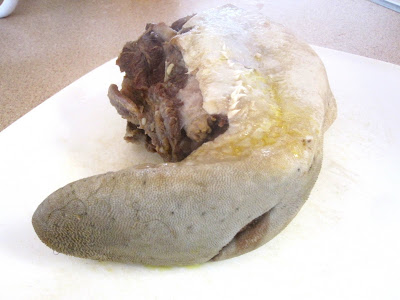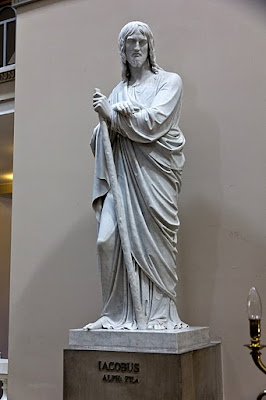The Church of Our Lady (Vor Frue Kirke) in Copenhagen, Denmark,
is the cathedral of Copenhagen and the National Cathedral of Denmark.
The Church of Our Lady, Copenhagen’s Cathedral, has been rebuilt four times. It was originally constructed in 1209 out of limestone. It burned down and was reconstructed in 1316, then burned again in 1728. The third church was rebuilt in 1738 and was destroyed in 1807 by the British during the bombardment of Copenhagen during the Napoleanic wars. The Pantheon in Rome was a model for the fourth church, including the front pediment supported by columns.
The fourth church was under construction for 12 years, from 1817 to 1829. The outside is extremely simple and the inside nearly so. The statues outside the church are David
and Moses.
What really makes the church are the statues of Christ and his 12 apostles by the Danish sculptor Bertel Thorvaldsen.
Thorvaldsen was born in Copenhagen in 1770 and accepted to the Royal Danish Academy of Art at age 11. He went to Rome to continue his education in 1796 and there developed a large sculpture workshop. In 1819 he visited Denmark and was commissioned to make the statues of Christ and the twelve apostles for the fourth church which was replacing the church destroyed in 1807. After Thorvaldsen returned to Rome he started to work on those pieces and did not finally complete them until just before he returned to Denmark in 1838, at age 68, bringing the finished pieces, as a national hero. Christ, or the Christus, is placed in front of the chancel (picture by Scott Zimmerman)
and the apostles are in two rows going down both sides of the nave (picture by Scott Zimmerman).
To Christ’s right are Peter, then Matthew, John, James the Less, Philip and Thaddeus. To Christ’s left are Paul, Simon Zelotes, Bartholomew, James the Greater, Thomas and Andrew. In addition, Thorvaldsen made a gift to the church of a baptismal font held by a guardian angel which he sculpted.
In 1896 a textbook proclaimed the statue of the resurrected Christ, commonly referred to as the Christus, as the “most perfect statue of Christ in the world.”
Stephen L. Richards, a member of the LDS Church Quorum of the Twelve, purchased a replica of the Christus (he had been inspired by the original in the Church of Our Lady on a visit in 1950) and presented it to the LDS Church as an anonymous gift. Even before it was put on display at the Visitor’s Center on Temple Square in Salt Lake City, the Church commissioned another replica to be shown at the New York World’s Fair in 1964. The Church has since commissioned about 15 more replicas and has placed them in visitor centers in Los Angeles, New Zealand, Hawaii, Mexico, Japan, Iceland and other locations. Pictures of the Christus are displayed in many LDS publications and web sites and for many people the Christus has become “synonymous with Mormonism.”
Peter
is represented with crossed keys representing the authority given him by Christ.
Boyd K. Packer relates that in 1976 he was with Spencer W. Kimball, then President of the LDS Church, at a conference in Copenhagen. President Kimball invited a small group to the Church of Our Lady to see the Christus. While standing near the statue of Peter, depicted as holding keys in his hand, President Kimball turned to Johan H. Benthin, President of the Copenhagen Stake, and told him, “I want you to tell every prelate in Denmark that they do not hold the keys! I hold the Keys!” (“The Shield of Faith,” Ensign (CR), May 1995, p. 7) Matthew is often pictured as a bearded old man, accompanied by an angel dictating his Gospel.
John has a book and an eagle.
The eagle may represent his evangelism and the book may represent the book of Revelation which he is said to have written on the Isle of Patmos, as well as the Gospel of John. James the Less (son of Alpheus) was said to have been killed when struck in the head by a fuller’s pole (picture by Scott Zimmerman),
thus he is represented with such a pole. Fulling is a special process in the manufacture of cloth by which it is cleansed and thickened. Philip is represented with a Latin cross, a cross with a longer descending arm, representing the cross of Jesus’ crucifixion (picture by Scott Zimmerman).
This is the symbol assigned to him by the Catholic church. Jude (Thaddeus) is represented with a broad axe because he is said to have suffered martyrdom in Suanis, then subject to Persia, after being clubbed insensible, then killed when his head was shattered with a broad axe.
Paul, who replaces Judas Iscariot, is often represented with a bushy beard and with a sword.
The sword represents the spirit and it may also represent his martyrdom, as tradition has his death by beheading in Rome. Simon Zelotes, or Simon the Zealot, is represented with a saw because one tradition has him killed by being sawn in half at Suanir, Persia.
Bartholomew (perhaps the same as Nathanael) was killed in Armenia by being flayed alive (picture by Scott Zimmerman).
He is believed to have spread the gospel in Lycaonia (southern Asia Minor), India and Armenia (east of Turkey and northwest of Iran). He is represented with a flaying knife because of how he was martyred.
James the Great is represented with a pilgrim staff (as patron of pilgrims).
I love his hat.
Thomas stands with a carpenter's square
which stands for the church Thomas is said to have built with his own hands in India.
Andrew is often depicted as an old man with a white beard leaning on a saltire,
which is an X-shaped cross. Andrew was killed in modern-day Patras, in western Greece in the Peloponnesus, preaching until he died while bound to a cross. The X-shaped cross story arose in the Middle Ages.
There are other some other
simple decorative items in the church
but nothing like the statues just identified.

The reformation came to Denmark in 1536 and Catholicism was abolished. Evangelical Lutheranism was selected to be the national church of Denmark. The Evangelical Lutheran Church of Denmark, commonly known as the Church of Denmark, is the national church of Denmark and is supported by the government, although membership is voluntary. The Queen of Denmark heads the Church, the Minister for Ecclesiastical Affairs is the highest administrative authority and the Danish parliament is the supreme legislative authority for the church. At the beginning of 2011, 80.4% of the population of Denmark were members of the church, although only 65% in the Diocese of Copenhagen. The percentage has been declining due to immigration from non-Lutheran countries, fewer infants being christened (only 73%) and withdrawal of some members. Less than 5% attend services each week, but the churches are still widely used for christenings, confirmations, weddings and funerals. The Church of Denmark just recently joined the Porvoo Communion (named after Porvoo, Finland, where there was a celebration of Holy Communion after the formal signing), a group of churches which have full communion between themselves (substantially similar doctrines). The other churches are: (i) the Evangelical Lutheran Church of Iceland; (ii) the Evangelical Lutheran Church of Finland; (iii) the Church of Sweden; (iv) the Church of Norway; (v) the Evangelical Lutheran Church of Lithuania; (vi) the Estonian Evangelical Lutheran Church; (vii) the Scottish Episcopal Church; (viii) The Church of Ireland; (ix) the Church in Wales; (x) the Church of England; (x) the Lusitanian Catholic Apostolic Evangelical Church of Portugal; and (xii) the Spanish Reformed Episcopal Church.
There are 12 dioceses in the Church of Denmark, including the Diocese of Copenhagen. Two are located outside of Denmark: the Diocese of Greenland and the Diocese of the Faeroe Islands.



















































